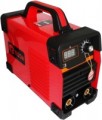Power consumption
The maximum power consumed by the welding machine during operation, expressed in kilowatts (kW), that is, thousands of watts. In addition, the designation in kilovolt-amperes (kVA) can be used, see below for it.
The higher the power consumption, the more powerful the current the device is capable of delivering and the better it is suitable for working with thick parts. For different materials of different thicknesses, there are recommendations for current strength, they can be clarified in specialized sources. Knowing these recommendations and the open circuit voltage (see below) for the selected type of welding, it is possible to calculate the minimum required power of the welding machine using special formulas. It is also worth considering that high power creates corresponding loads on the wiring and may require connection directly to the shield.
As for the difference between watts and volt-amperes, the physical meaning of both units is the same — current times voltage. However, they represent different parameters. In volt-amperes, the total power consumption is indicated — both active (going to do work and heat individual parts) and reactive (going to losses in coils and capacitors). This value is more convenient to use to calculate the load on the power grid. In watts, only active power is recorded; according to these numbers, it is convenient to calculate the practical capabilities of the welding machine.
Duty cycle
The duty cycle allowed for the welding machine.
Almost all modern welding machines require breaks in operation — for cooling and general "recovery". The frequency of inclusion indicates what percentage of the time of the total work cycle can be used directly for work. In this case, 10 minutes is usually taken as a standard cycle. Thus, for example, a device with a duty cycle of
30% will be able to work continuously for less than 3 minutes, after which it will need at least 7 minutes of interruption. However, for some models, a cycle of 5 minutes is used; these nuances should be clarified according to the instructions.
In general, high frequency is required mainly for high-volume professional work; with a relatively simple application, this parameter does not play a decisive role, especially since you have to take breaks during work. As for specific values, the mentioned 30% is a very limited figure, typical mainly for entry-level devices. A value of
30 – 50% is also low; in the range of
50 – 70% is the majority of modern devices, and the most "hardy" models provide a frequency
of more than 70%.
Insulation class
The insulation class determines the degree of resistance of the insulating materials used in a particular device to heat. To date, welding machines use materials mainly of the following classes:
B — have a resistance limit of 130 °C;
F — 155 °C;
H — 180 °C.
Note that the vast majority of modern welding machines have electronic overheating protection, which turns off the device long before reaching the insulation resistance limit. Therefore, this parameter will be relevant only in an emergency, when the built-in protection fails. Nevertheless, it fully allows you to assess the safety of using the device — the higher the insulation class, the more likely it is to notice dangerous overheating in time (for example, by a characteristic smell) and turn off the device before damage occurs.
Electrode holder cable
The length of the electrode holder cable supplied with the device.
As the name implies, this cable is used to connect the clamp for the welding electrode to the machine. The longer such a wire is, the more freedom the welder has in moving, the farther he can go without moving the machine itself. On the other hand, excessively long cables create problems in storage and transportation, and often during operation (you need to look for a place where to place the excess wire). Therefore, when choosing, you should proceed from what is more important for you: the ability to move away from the device or the overall compactness. As for specific numbers, most often the length of this wire varies from 2 to 3 m, but in some models it can reach 5 m.
Mass cable
The length of the ground cable supplied with the machine.
The mass cable is a wire that is connected to the workpiece with a clamp. In other words, this is the second contact required to close the circuit during electric welding; connecting such a wire actually turns the workpiece into one solid fixed electrode (paired with a movable welding electrode). As for the length of such a wire, the longer it is, the farther from the connection point you can place the machine and the more freedom of movement the welder gets. On the other hand, excessively long wires create problems in storage and transportation, and often during work (you need to look for a place where to place the excess cable). In addition, freedom of movement can be ensured by increasing the length of the second wire — for the electrode holder or burner. Thus, the mass cable in modern welding machines usually has a length of 1.2 to 3 m (with some exceptions — both smaller and larger). This length allows you to comfortably place the device and at the same time does not create problems.

